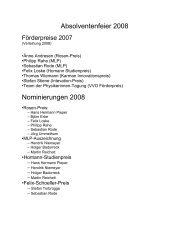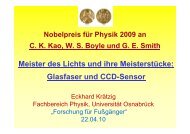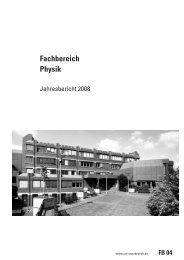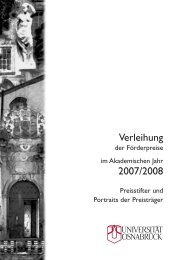Universität Osnabrück, Graduiertenkolleg Mikrostruktur oxidischer
Universität Osnabrück, Graduiertenkolleg Mikrostruktur oxidischer
Universität Osnabrück, Graduiertenkolleg Mikrostruktur oxidischer
Erfolgreiche ePaper selbst erstellen
Machen Sie aus Ihren PDF Publikationen ein blätterbares Flipbook mit unserer einzigartigen Google optimierten e-Paper Software.
GRADUIERTENKOLLEG MIKROSTRUKTUR OXIDISCHER KRISTALLE 21<br />
The Fe1-xCuxCr2S4 (x=0.0; 0.5) are ferrimagnetic semiconductors, whereas the end member of the series,<br />
CuCr2S4, is a ferromagnetic metal. In FeCr2S4 the Fe 2+ and Cr 3+ ions have the 3d 6 and 3d 3 electronic configurations,<br />
respectively. For CuCr2S4 the question of the Cu valence state has been a longstanding problem. In connection<br />
with this, two models were proposed by Lotgering [10] and Goodenough [11]. The first model claimed<br />
that the Cu valence state should be monovalent (Cu 1+ ) whereas the second one claimed that Cu is divalent (Cu 2+ )<br />
. For the Fe0.5Cu0.5Cr2S4 system the situation becomes even more complicated, since several possibilities can<br />
occur for the substitution of Cu for Fe, depending on whether Cu is present as Cu 1+ or Cu 2+ .<br />
The vanadium oxides have been extensively studied over the past few decades due to their interesting<br />
electric and magnetic properties. It is well known that many compounds may form in the vanadium-oxygen<br />
system, such as V2O5, V2O3, VO2, VO, VnO2n-1 (Magneli phases) and V2nO5n-2 (Wadsley phases). Most of the<br />
vanadium oxides exhibit metal-to-insulator transitions (MIT) and many experimental and theoretical studies<br />
have been done in order to investigate the mechanism behind MIT [12]. Despite this, there are still open questions<br />
related to the surface characterization of V2O5, the phase transitions mechanism in V2O3 and VO2, which is<br />
related by some authors to a Mott-Hubbard scenario [13], whereas others attribute it to the electron-phonon<br />
coupling on the basis of the change in the crystal symmetry [14].<br />
Ergebnisse<br />
We have investigated the changes induced in the electronic structure of LaMnO3 by various dopants, as<br />
Sr, Ba, Ca, Pb by using XPS and XES. From the XPS valence band (VB) and XES Mn Lα and O Kα spectra<br />
the O 2p and Mn 3d electronic states distribution in the VB was determined. A strong hybridization between the<br />
Mn 3d and O 2p states was observed (see Fig.1), in good agreement with the band structure calculations [15].<br />
The wide band in the VB spectra was associated with the Mn t2g↑ hybridized with O 2p states and the structure<br />
close to the Fermi level was identified as mainly reflecting the Mn eg↑ states.<br />
In order to estimate the valence state of manganese ions we have analyzed the Mn 2p and 3s core level<br />
spectra. The splitting of the 3s XPS spectra of transition metals and their compounds originates from the exchange<br />
coupling between the 3s core hole created during the XPS process and its magnitude is proportional to<br />
the local spin of the 3d electrons in the ground state [16]. We have investigated La1-xSrxMnO3 single crystals in a<br />
doping regime 0.1







